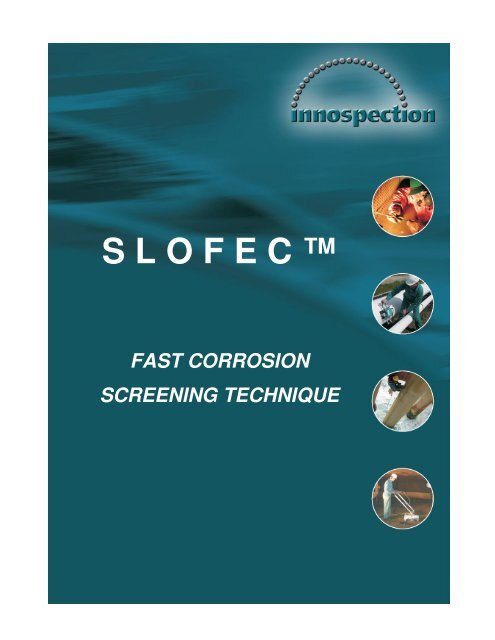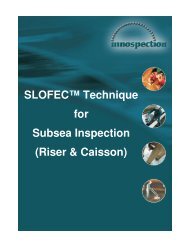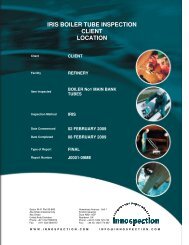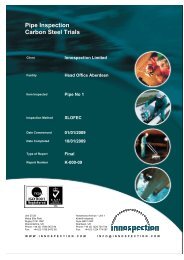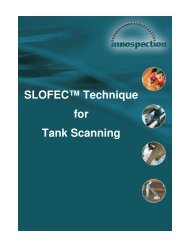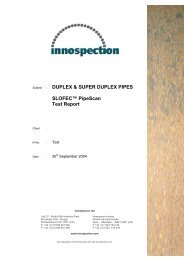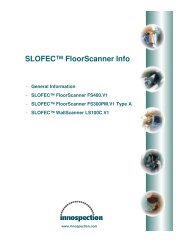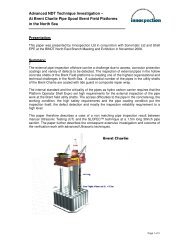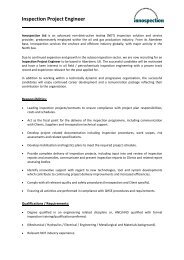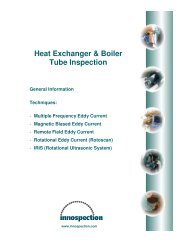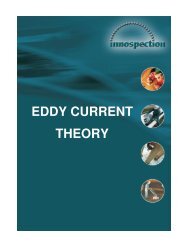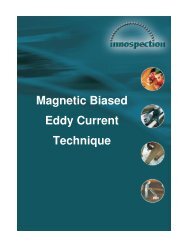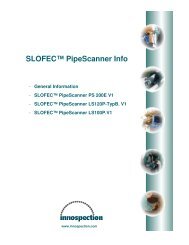SLOFEC Technique - Innospection
SLOFEC Technique - Innospection
SLOFEC Technique - Innospection
You also want an ePaper? Increase the reach of your titles
YUMPU automatically turns print PDFs into web optimized ePapers that Google loves.
S L O F E C <br />
FAST CORROSION<br />
SCREENING TECHNIQUE
<strong>SLOFEC</strong> <strong>Technique</strong><br />
<strong>SLOFEC</strong> refers to Saturated Low Frequency Eddy Current.<br />
<strong>Innospection</strong> Ltd is the main provider of the <strong>SLOFEC</strong> inspection services and is the sole<br />
licensed <strong>SLOFEC</strong> operator in the United Kingdom, Australia, Middle East, South Africa,<br />
Malaysia etc.<br />
The <strong>SLOFEC</strong> technique is the world’s leading technology for fast scanning and has the<br />
exceptional capabilities to deliver unmatched high quality defect reports. The main<br />
applications of this technique are the inspection of storage tanks, pipelines, vessels and<br />
other type of steel constructions.<br />
Page 2 of 10
<strong>SLOFEC</strong> <strong>Technique</strong><br />
Principle of the <strong>SLOFEC</strong> <strong>Technique</strong><br />
The <strong>SLOFEC</strong> inspection technique uses the eddy current principle in combination with a<br />
magnetic field. Utilising superimposed DC-magnetisation, the depth of penetration of the<br />
eddy current field lines in the ferromagnetic material is increased.<br />
In case of a defect, the magnetic field lines have a higher density in the remaining wall<br />
thickness, which consequently changes the relative permeability in the area, which again<br />
changes the eddy current field lines, as shown in Diagram 1.<br />
Induced voltage for probe<br />
in non-defect area<br />
0<br />
+ -<br />
MAGNET<br />
EDDY<br />
CURRENT<br />
SENSORS<br />
EDDY<br />
CURRENT<br />
FIELD LINES<br />
Induced voltage for probe<br />
in defect area<br />
0<br />
+ -<br />
TEST PIECE<br />
MAGNETIC<br />
FIELD LINES<br />
DEFECT<br />
COMPRESSED<br />
MAGNETIC<br />
FIELD LINES<br />
Diagram 1<br />
The changes of the eddy current field lines are measured and analysed in comparison to its<br />
calibration in difference of the signal amplitude and the signal phase.<br />
The individual analysis capabilities of the signal phase, signal amplitude and signal shape<br />
provides the substantial advantage for the evaluation of:<br />
<br />
<br />
<br />
<br />
<br />
<br />
defect severity in wall loss<br />
distinguishing top side from underside defects<br />
analysing the volume of the defect<br />
distinguishing defects of false calls or laminations or inclusions<br />
adapting frequency to higher lift off<br />
allowing separating noise signals from defect signals<br />
Page 3 of 10
<strong>SLOFEC</strong> <strong>Technique</strong><br />
The <strong>SLOFEC</strong> inspection makes use of Eddy Current Differential Channel for the detection of<br />
localised material changes i.e. defects. Diagram 2 shows the signal response to a local and<br />
gradual defect.<br />
Diagram 2:<br />
Signal response to defects<br />
The scan results are shown with the internal defects on the underside having a vertical<br />
signal orientation while the external defects on the topside will a horizontal signal orientation.<br />
Diagram 3 shows the signal phase separation between the external and internal defects.<br />
Diagram 3:<br />
Signal phase separation between external and internal defects<br />
Page 4 of 10
<strong>SLOFEC</strong> <strong>Technique</strong><br />
In the inspection software, the analysis capabilities of signal phase separation and amplitude<br />
analysis is used with calibrated amplitude / phase to colour palettes, thus allowing the<br />
simultaneous evaluation of top side and under side defects, as shown in Diagram 4.<br />
Software Selecting color<br />
image window<br />
Top Side<br />
Under Side<br />
Top-side phase to defect<br />
depth analysis window<br />
Under-side phase to<br />
defect depth analysis<br />
window<br />
COLOUR PALETTE – DEFECT CLASSIFICATION:<br />
< 20% 20 - 30% 30-40% 40-50% >50%<br />
Diagram 4:<br />
Simultaneous Signal Phase and Amplitude analysis<br />
(depth in 10% steps)<br />
Due to the possibilities of adapting the eddy current frequency and reacting on the magnetic<br />
field line changes inside the material, <strong>SLOFEC</strong> can be used for the inspection of materials<br />
from low to high wall thicknesses as well as the inspection on top of the coatings.<br />
Our inspection experience is up to 33mm material wall thickness and coating thickness of up<br />
to 10mm. <strong>Innospection</strong>’s Riser Tool can inspect up to a coating thickness of 15mm.<br />
Because <strong>SLOFEC</strong> is an electromagnetic technique, direct surface coupling is not necessary.<br />
And as with all electromagnetic based techniques, the <strong>SLOFEC</strong> <strong>Technique</strong> is not an<br />
absolute wall thickness measurement technique like the Ultrasonic Testing and is to be<br />
considered as a comparison technique, which means that a calibration with reference to a<br />
sample as close as possible in material properties and geometry is required for the<br />
inspection. <strong>Innospection</strong> has set up a wide range of calibration sample stock, which covers<br />
typical required reference samples.<br />
Page 5 of 10
<strong>SLOFEC</strong> <strong>Technique</strong><br />
Key Features and Technical Advantages of the <strong>SLOFEC</strong> <strong>Technique</strong><br />
1) Capability of inspecting ferromagnetic and non-ferromagnetic materials<br />
The <strong>SLOFEC</strong> technique is regarded as a fully accepted Non Destructive Testing (NDT)<br />
technique in an increasing number of industries. The Oil & Gas industry recognises the<br />
advantages of this technique for the inspection of ferromagnetic and non-ferromagnetic<br />
materials such as carbon steel, stainless steel, duplex and super duplex materials.<br />
This technique has also been proven in the fields as a high speed and reliable method<br />
for the detection of local corrosion in pipelines, pressure vessels, storage tanks,<br />
caissons and risers as well as other types of steel constructions<br />
2) High inspection speed<br />
The <strong>SLOFEC</strong> technique allows the fast screening of large areas with low surface<br />
preparations prior to the inspection.<br />
3) High inspection temperature range<br />
The <strong>SLOFEC</strong> technique allows the Inspection at high temperatures, with up to date<br />
experience of up to 150ºC.<br />
4) High defect detection sensitivity and reliability<br />
The ability of the <strong>SLOFEC</strong> technique to inspect through different coatings and cladding<br />
types, under high temperatures and through thick wall components provides the<br />
advantages of using the <strong>SLOFEC</strong> technique not only for risk based inspection but also<br />
as a Non Intrusive Inspection (NII) strategy.<br />
The <strong>SLOFEC</strong> technique is highly sensitive in the detection of corrosion within a large<br />
wall thickness range, with the up-to-date experience from 0mm to 33mm.<br />
The extended thickness capability allows this technique to be suitable not only for the<br />
inspection of thick wall components but also for thinner walls covered with thick nonmetallic<br />
protection layers such as glass fibre reinforced epoxy coatings on floors of (oil)<br />
storage tanks. Our experience in inspection through thick coatings is up to 10mm.<br />
The <strong>SLOFEC</strong> technique is also capable of scanning welds covered by very thick<br />
linings, e.g. shell-to-annular welds in lined tanks.<br />
5) Distinction between external and internal defects<br />
The <strong>SLOFEC</strong> technique has the unique and useful feature of differentiating between<br />
the defects on the Top-Side, Under-side and through holes. It is also very sensitive in<br />
the detection of smaller volumetric defects.<br />
Page 6 of 10
<strong>SLOFEC</strong> <strong>Technique</strong><br />
In the detection of corrosion, this technique is able to detect the different types of<br />
defect profiles, such as:<br />
<br />
<br />
<br />
<br />
<br />
single isolated pits<br />
groups of corrosion attack<br />
small shallow and narrow pits in their early stage of defect development (to be<br />
noted as an early warning sign)<br />
shallow rounded pits with different diameters that are particularly difficult to detect<br />
with conventional manual ultrasonic<br />
Microbiological Induced Corrosion (MIC)<br />
6) Capability of real time scan results with coloured defect mapping<br />
The <strong>SLOFEC</strong> scan results are mapped out in real time which allows for speedy<br />
indications of defects in the inspected materials.<br />
The coloured reporting capability of the <strong>SLOFEC</strong> technique for the corrosion mapping<br />
provides an overview on the condition of the inspected component which allows for the<br />
evaluation, determination of corrective actions and modifications to future maintenance<br />
and inspection strategies.<br />
Page 7 of 10
<strong>SLOFEC</strong> <strong>Technique</strong><br />
Reporting Software of <strong>SLOFEC</strong><br />
The <strong>SLOFEC</strong> scan results are mapped out in real time which allows for speedy indications of<br />
defects in the inspected materials. The coloured reporting software of <strong>SLOFEC</strong> for corrosion<br />
mapping provides not only a condition overview but displays as well the condition of the<br />
individual sections of the inspected object.<br />
The easy handling of the reporting software enables the setting up of the required colour<br />
levels for the defect severity display. As with no other inspection techniques, it also allows<br />
the separate reporting of the top side condition from the under side condition, which makes<br />
this software highly interesting for storage tanks inspections.<br />
The software has also the additional feature of including individual defect analysis, statistical<br />
analysis of defects, repair plate modes, as well as for adding other results as Ultrasonic<br />
verifications and more.<br />
This allows the evaluation and determination of corrective actions and modifications to future<br />
maintenance and inspection strategies.<br />
In the reporting layout, the inspection data is precisely added and an easy coloured condition<br />
overview is displayed. The colour criteria and threshold can be set up to the required criteria.<br />
The diagram below shows an example of the topside condition of a tank floor scan sample<br />
coloured map report.<br />
Diagram 5:<br />
Top-side scan sample coloured map report<br />
Page 8 of 10
<strong>SLOFEC</strong> <strong>Technique</strong><br />
Comparison between <strong>SLOFEC</strong> and MFL techniques<br />
Due to its electromagnetic technical background, the <strong>SLOFEC</strong> <strong>Technique</strong> is often compared<br />
to the Magnetic Flux Leakage (MFL) technique. However the advantages of the <strong>SLOFEC</strong><br />
technique against MFL are proven to be multiple.<br />
A study was conducted by an independent party to compare the relative defect detection<br />
sensitivity and wall thickness range of the <strong>SLOFEC</strong> technique for tank floor inspection with<br />
the typical MFL floor scanning technique. The detection tests were performed with the use of<br />
spherical test defects of different plates. The result was set up in the relative detection<br />
sensitivity versus wall thickness graph.<br />
The results in Diagram 6 clearly identified the substantial detection and wall thickness range<br />
advantage of the <strong>SLOFEC</strong> technique i.e. <strong>SLOFEC</strong> has a better defect detection sensitivity<br />
than the MFL technique.<br />
Relative Detection Sensitivity<br />
MFL<br />
<strong>SLOFEC</strong><br />
WT<br />
d<br />
2d<br />
d / WT =<br />
detectability [%]<br />
2 4 6 8 10 12 14 16 18 20 22 24 26 28 30 32 34 36<br />
Wall thickness [mm]<br />
Diagram 6:<br />
Floorscan “Relative Detection Capability versus Wall Thickness”<br />
<strong>SLOFEC</strong> versus MFL<br />
In comparison with other technologies like the MFL technique, the <strong>SLOFEC</strong> technique is<br />
capable of scanning in excess of 3 times the material thicknesses and scanning through<br />
coatings in excess of 5 times the thicknesses. It has also the powerful capabilities of<br />
detecting defects less than half the size of that which can be detected with the MFL<br />
technique.<br />
Page 9 of 10
<strong>SLOFEC</strong> <strong>Technique</strong><br />
Qualification tests conducted by various Oil & Gas organizations showed detection<br />
sensitivity of even the smallest diameter defects (pits). Below is an example for the<br />
qualification for an international storage tank floor inspection work.<br />
The results showed detection capabilities of the following small defects in the plates with<br />
different thickness (with and without coating):<br />
9mm thick plate defect detected from Ø 2mm, depth 20%<br />
12mm thick plate defect detected from Ø 2mm, depth 20%<br />
21mm thick plate defect detected from Ø 4mm, depth 20%<br />
An inspection through coatings of up to 10mm on tank floors and up to 6mm on pipes was<br />
performed. The scanners were equipped with multiple sensor arrays which allowed a<br />
sufficient resolution while scanning. All scanners were connected to the same Eddy Current<br />
Multiple Channel system operated online, allowing the inspection operator to view and<br />
analyse online each individual indication.<br />
The signal distinction between the defect and non defect analysis by eddy current signal<br />
phase and shape prevents colour reporting of false calls such as inclusions, laminations or<br />
surface deposits. Due to this fact, the surface preparation for the <strong>SLOFEC</strong> inspection is<br />
lower than for other techniques like MFL.<br />
In different applications and analysis with major oil & gas operators, the following key<br />
features and capabilities were identified with the <strong>SLOFEC</strong> technique:<br />
<br />
<br />
<br />
<br />
Good detection capabilities for corrosion defects such as Microbiological Induced<br />
Corrosion (MIC or RSB)<br />
Relative equal defect depth analysis of different defect top shapes (flat bottom, spherical<br />
or conical top shape)<br />
Very good signal noise ratio on higher temperatures<br />
Corrosion detection even along the welds<br />
Over the past years, this technique has not only developed into a much used technique in<br />
the oil & gas and petrochemical industry, it has also become an important inspection part of<br />
Risk Based Inspection Strategies and Non Intrusive Inspection Strategies. More importantly,<br />
it is used as a fast and reliable general corrosion detection tool.<br />
Page 10 of 10


